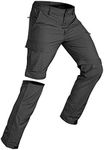Buying Guide for the Best Mens Convertible Hiking Pants
Choosing the right men's convertible hiking pants can make your outdoor adventures much more comfortable and enjoyable. Convertible hiking pants are designed to offer flexibility, allowing you to switch between pants and shorts as the weather or your activity changes. When shopping for these pants, it's important to consider how and where you'll be using them, as well as your personal comfort preferences. Understanding the key features will help you find a pair that suits your needs and keeps you comfortable on the trail.MaterialThe material of convertible hiking pants determines their comfort, durability, and how well they handle moisture. Most are made from synthetic fabrics like nylon or polyester, which are lightweight, quick-drying, and resistant to abrasion. Some may include a bit of spandex for stretch. Lightweight materials are great for warm weather and fast-paced hikes, while heavier or reinforced fabrics are better for rugged terrain or cooler climates. If you expect to hike in hot, humid, or wet conditions, prioritize quick-drying and breathable fabrics. For rougher trails, look for pants with reinforced areas or thicker weaves.
Fit and ComfortFit refers to how the pants sit on your body, including the waist, hips, and legs. Comfort is influenced by the cut, waistband style, and whether the pants have features like articulated knees or gusseted crotches for easier movement. Slim or straight fits are more streamlined and less likely to snag, while relaxed fits offer more room for layering or freedom of movement. If you plan on long hikes or lots of climbing, look for pants with stretch panels or articulated knees. Try on different fits to see what feels best for your body and activity level.
Zipper Quality and PlacementConvertible pants have zippers at the knees that allow you to remove the lower legs and turn the pants into shorts. The quality and placement of these zippers are important for comfort and ease of use. Well-made zippers should move smoothly and not irritate your skin. Some pants have color-coded or angled zippers to make reattaching the legs easier. If you plan to convert your pants often, look for smooth, non-chafing zippers that are easy to operate even with cold or wet hands.
Pockets and StoragePockets provide storage for small items like maps, snacks, or a phone. The number, size, and placement of pockets can vary widely. Some pants have zippered pockets for security, while others have cargo pockets for extra space. If you like to keep essentials close at hand, look for pants with multiple, well-placed pockets. For minimalists or those who use a backpack, fewer pockets may be preferable to reduce bulk.
Sun and Water ProtectionMany hiking pants offer built-in sun protection (measured as UPF rating) and water-repellent coatings. UPF ratings indicate how well the fabric blocks UV rays, which is important for long hikes in sunny areas. Water-repellent finishes help keep you dry in light rain or when walking through wet vegetation. If you hike in sunny or variable weather, look for pants with a UPF rating of 30 or higher and a durable water-repellent (DWR) finish. For mostly shaded or dry environments, these features may be less critical.
Weight and PackabilityThe weight of the pants affects how comfortable they are to wear and how easy they are to pack. Lightweight pants are ideal for warm weather and when you want to minimize your load, while heavier pants may offer more durability and protection. Some convertible pants pack down small, making them easy to stash in your backpack when not in use. If you value traveling light or need to carry extra gear, prioritize lightweight and packable options.
















